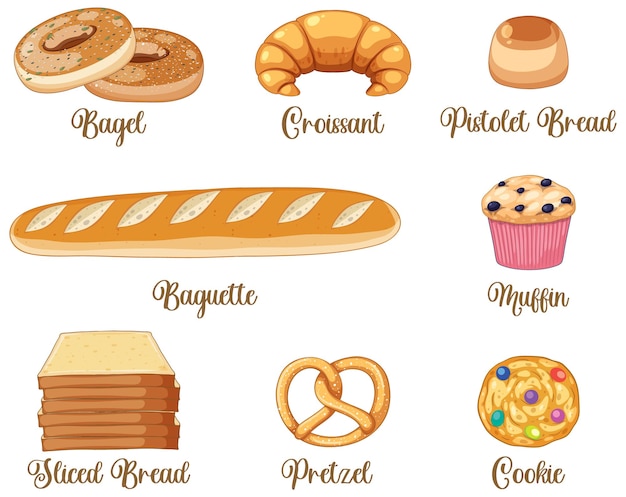Cake And Bakery Shop-- Variety of Cakes and Baked Item
Wiki Article
From Sourdough to Croissants: Types of Breads and Pastries You Must Attempt
Checking out the diverse world of bread and breads exposes a detailed tapestry of tastes and textures, each with its very own one-of-a-kind tale. From the appetizing complexity of sourdough, soaked in practice and natural fermentation, to the refined flakiness of croissants, personifying French cooking mastery, there is much to discover. Take into consideration the famous baguette, with its crisp exterior and airy crumb, or the buttery splendor of brioche. Even the elaborate layers of Danish pastries, often loaded with lush custards or fruits, provide a fascinating comparison. What makes each of these creations absolutely special? The answer exists just ahead.Sourdough Bread
Sourdough bread, renowned for its distinctive appetizing taste and chewy structure, is an ageless classic that has been valued for centuries. Originating as a staple in ancient human beings, this artisanal bread owes its unique attributes to the all-natural fermentation process including wild yeast and lactic acid microorganisms. The lack of commercial yeast enables for a slower fermentation, which boosts the deepness of flavor and leads to a much more absorbable loaf.When introduced to dough, the starter initiates fermentation, producing bubbles of carbon dioxide that provide the bread its airy structure. The prolonged fermentation period not only enhances the structure however likewise damages down gluten and phytic acid, making sourdough a lot more nourishing and easier on the gastrointestinal system.
Artisans around the world take pride in their special sourdough dishes, each showing regional components and conditions - Lofology Bakery And Cafe. Whether appreciated plain, toasted, or as a structure for exquisite sandwiches, sourdough bread remains a long-lasting icon of cooking workmanship and tradition

Baguettes
Though frequently related to the cooking customs of France, baguettes have become a precious staple in bakeshops around the world. Well-known by their lengthened shape and crisp, golden-brown crust, baguettes are usually taken into consideration the epitome of simple, yet exquisite, bread-making (Cafe Shop). The beginnings of the baguette in its modern kind can be traced back to the very early 20th century, when improvements in baking technology enabled the development of this distinct loaf
At its core, a standard baguette comprises simply four ingredients: flour, water, yeast, and salt. Nonetheless, the mastery depends on the method. The dough undertakes a precise process of massaging, proofing, and baking, which causes its characteristic structure-- a slim, crackly crust covering a soft, ventilated interior. This association of textures is a defining attribute that adds to the baguette's extensive honor.
Baguettes are functional and can be enjoyed in various ways. Whether sliced and offered with butter, coupled with cheeses and charcuterie, or used as the foundation for a sandwich, the baguette uses a wonderful consuming experience. This unassuming loaf showcases the charm of simplicity, making it a long-lasting fave amongst bread fanatics globally.
Croissants
Popular for their buttery, flaky layers, croissants stand as an ultimate icon of French bread workmanship. Stemming from Austria yet perfected in France, croissants are a staple in patisseries and bakeries worldwide (Lahore Bakery). Their manufacturing entails a thorough process referred to as lamination, where dough is folded with butter several times to produce slim layers that expand perfectly when bakedThe key to a perfect croissant hinges on the quality of ingredients and the precision of method. High-fat European butter, rich in flavor, is vital for accomplishing the preferred flakiness and golden color. The dough needs to be managed gently to preserve the stability of the layers, making certain a ventilated, light inside. The last item must flaunt a crisp exterior and a tender, somewhat chewy inside, releasing a rich, buttery aroma upon splitting.
Croissants can be enjoyed simple or full of a selection of active ingredients such as almond paste, delicious chocolate, or ham and cheese, offering versatility to match various tastes buds. Whether enjoyed as an early morning extravagance or a mid-day reward, croissants illustrate the artistry of French baking, making them a must-try for any type of culinary lover.
Brioche
Brioche's rich history and lavish appearance make it a standout on the planet of bread and breads. Originating from France, this sweet, buttery bread go back to at the very least the 15th century and has actually considering that come to be a sign of indulgence and culinary skill. Its name, stemmed from the Old French term "brier," implying to knead, highlights the importance of technique in its prep work.The key to brioche's distinctive character exists in its enriched dough, which is laden with eggs and butter, causing a tender crumb and a golden, half-cracked crust. This high-fat content not just enhances its taste however also adds to its soft, pillowy structure. Brioche's versatility is one more factor for its extensive acclaim. It can be enjoyed plain, toasted with a touch of jam, or utilized as the base for more sophisticated developments such as brioche à tête, hamburger buns, and even bread pudding (Cafe Shop).
Despite its relatively straightforward ingredients, the art of crafting an ideal brioche needs accuracy and patience. The dough goes through a thorough process of kneading, resting, and proofing, making sure that each loaf attains its particular agility and splendor. This commitment to quality and tradition cements brioche's condition as an ageless standard in the pastry shop repertoire.

Danish Breads
see here now
Danish breads are commemorated for their adaptability. The addition of toppings like nuts, topping, or fresh fruit typically improves their aesthetic allure and taste account.
The process of making Danish pastries demands precision. The dough should be maintained an ideal temperature to guarantee the butter layers stay distinctive, and the folding method calls for a careful hand to attain the perfect equilibrium of flakiness and inflammation.
In the context of worldwide bread offerings, Danish breads stick out not just for their precise workmanship yet also for their capability to give a wonderful ruptured of tastes and textures in every bite (Islamabad Bakery). A real testament to the art of cooking, they remain a cherished selection among pastry connoisseurs
Conclusion
The expedition of varied bread and pastry types, from the zesty depth of sourdough to the buttery flakiness of croissants, exposes an abundant tapestry of cooking traditions. The crisp crust and airy inside of baguettes, the luxurious richness of brioche, and the complex layers of Danish breads loaded with custard or fruit highlight the creativity associated with cooking. Each variety provides a distinctive sensory experience, emphasizing the significance of these baked products in worldwide cooking society.Report this wiki page